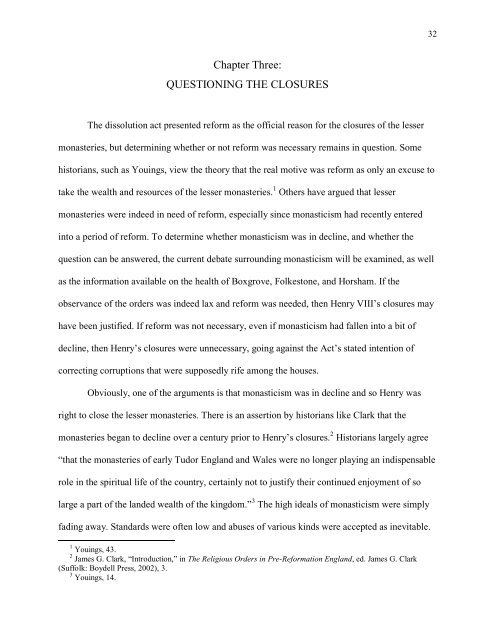The 1536 Dissolution of the Lesser Monasteries: Same Suppression ...
The 1536 Dissolution of the Lesser Monasteries: Same Suppression ...
The 1536 Dissolution of the Lesser Monasteries: Same Suppression ...
Create successful ePaper yourself
Turn your PDF publications into a flip-book with our unique Google optimized e-Paper software.
Chapter Three:<br />
QUESTIONING THE CLOSURES<br />
<strong>The</strong> dissolution act presented reform as <strong>the</strong> <strong>of</strong>ficial reason for <strong>the</strong> closures <strong>of</strong> <strong>the</strong> lesser<br />
monasteries, but determining whe<strong>the</strong>r or not reform was necessary remains in question. Some<br />
historians, such as Youings, view <strong>the</strong> <strong>the</strong>ory that <strong>the</strong> real motive was reform as only an excuse to<br />
take <strong>the</strong> wealth and resources <strong>of</strong> <strong>the</strong> lesser monasteries. 1 O<strong>the</strong>rs have argued that lesser<br />
monasteries were indeed in need <strong>of</strong> reform, especially since monasticism had recently entered<br />
into a period <strong>of</strong> reform. To determine whe<strong>the</strong>r monasticism was in decline, and whe<strong>the</strong>r <strong>the</strong><br />
question can be answered, <strong>the</strong> current debate surrounding monasticism will be examined, as well<br />
as <strong>the</strong> information available on <strong>the</strong> health <strong>of</strong> Boxgrove, Folkestone, and Horsham. If <strong>the</strong><br />
observance <strong>of</strong> <strong>the</strong> orders was indeed lax and reform was needed, <strong>the</strong>n Henry VIII‘s closures may<br />
have been justified. If reform was not necessary, even if monasticism had fallen into a bit <strong>of</strong><br />
decline, <strong>the</strong>n Henry‘s closures were unnecessary, going against <strong>the</strong> Act‘s stated intention <strong>of</strong><br />
correcting corruptions that were supposedly rife among <strong>the</strong> houses.<br />
Obviously, one <strong>of</strong> <strong>the</strong> arguments is that monasticism was in decline and so Henry was<br />
right to close <strong>the</strong> lesser monasteries. <strong>The</strong>re is an assertion by historians like Clark that <strong>the</strong><br />
monasteries began to decline over a century prior to Henry‘s closures. 2 Historians largely agree<br />
―that <strong>the</strong> monasteries <strong>of</strong> early Tudor England and Wales were no longer playing an indispensable<br />
role in <strong>the</strong> spiritual life <strong>of</strong> <strong>the</strong> country, certainly not to justify <strong>the</strong>ir continued enjoyment <strong>of</strong> so<br />
large a part <strong>of</strong> <strong>the</strong> landed wealth <strong>of</strong> <strong>the</strong> kingdom.‖ 3 <strong>The</strong> high ideals <strong>of</strong> monasticism were simply<br />
fading away. Standards were <strong>of</strong>ten low and abuses <strong>of</strong> various kinds were accepted as inevitable.<br />
1 Youings, 43.<br />
2 James G. Clark, ―Introduction,‖ in <strong>The</strong> Religious Orders in Pre-Reformation England, ed. James G. Clark<br />
(Suffolk: Boydell Press, 2002), 3.<br />
3 Youings, 14.<br />
32
















